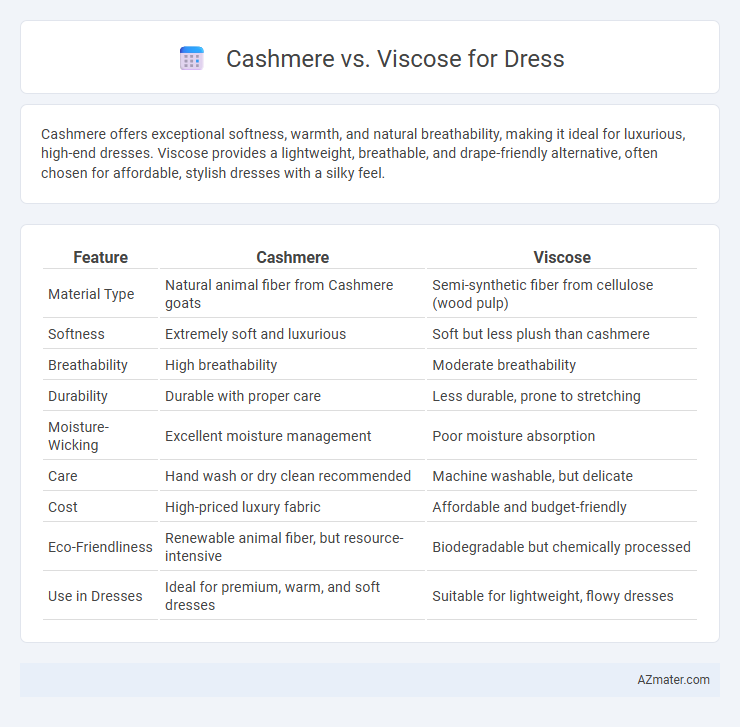Cashmere offers exceptional softness, warmth, and natural breathability, making it ideal for luxurious, high-end dresses. Viscose provides a lightweight, breathable, and drape-friendly alternative, often chosen for affordable, stylish dresses with a silky feel.
Table of Comparison
| Feature | Cashmere | Viscose |
|---|---|---|
| Material Type | Natural animal fiber from Cashmere goats | Semi-synthetic fiber from cellulose (wood pulp) |
| Softness | Extremely soft and luxurious | Soft but less plush than cashmere |
| Breathability | High breathability | Moderate breathability |
| Durability | Durable with proper care | Less durable, prone to stretching |
| Moisture-Wicking | Excellent moisture management | Poor moisture absorption |
| Care | Hand wash or dry clean recommended | Machine washable, but delicate |
| Cost | High-priced luxury fabric | Affordable and budget-friendly |
| Eco-Friendliness | Renewable animal fiber, but resource-intensive | Biodegradable but chemically processed |
| Use in Dresses | Ideal for premium, warm, and soft dresses | Suitable for lightweight, flowy dresses |
Introduction to Cashmere and Viscose
Cashmere, a luxury fiber derived from the undercoat of Cashmere goats, is renowned for its exceptional softness, warmth, and durability, making it a premium choice for high-end dresses. Viscose, a semi-synthetic fiber made from regenerated cellulose, offers a smooth, breathable, and lightweight fabric that drapes well and is often used as an affordable alternative to silk or cotton. Understanding the unique properties of Cashmere and Viscose helps in selecting the ideal material based on comfort, appearance, and garment care requirements.
Fabric Origins and Production Processes
Cashmere fabric is derived from the fine undercoat of cashmere goats, primarily found in regions such as Mongolia, China, and Nepal, harvested through a meticulous combing process during molting season. Viscose, on the other hand, is a semi-synthetic fiber produced from regenerated cellulose extracted mainly from wood pulp, involving chemical treatments and spinning processes to create a soft, silk-like texture. The natural origin and labor-intensive production of cashmere yield luxurious warmth and softness, while viscose offers an affordable, versatile fabric with breathable qualities derived through industrial manufacturing.
Texture and Feel Comparison
Cashmere offers a luxurious, soft texture with a natural warmth and a lightweight feel, making it ideal for cozy yet elegant dresses. Viscose, derived from cellulose fibers, provides a smooth, silky finish with excellent breathability and a cool touch against the skin. While cashmere delivers a plush and insulating experience, viscose excels in draping fluidity and moisture absorption, catering to different dresswear preferences.
Breathability and Comfort Levels
Cashmere offers superior breathability and natural insulation, making it ideal for maintaining comfort in varying temperatures, while viscose, a semi-synthetic fiber, provides excellent moisture-wicking properties for a cooler feel. Cashmere's softness and lightness contribute to a luxurious comfort level, whereas viscose excels in smoothness and drape, enhancing ease of wear. When choosing between the two for dresses, cashmere suits cooler climates for warmth and breathability, and viscose works better in warmer conditions due to its breathable and cooling characteristics.
Durability and Longevity
Cashmere offers superior durability and longevity compared to viscose due to its natural fiber strength and resilience against pilling and wear. Viscose, while soft and lightweight, tends to weaken and lose shape after repeated washing and exposure to moisture. Investing in cashmere dresses ensures long-lasting quality and sustained appearance, making them more durable for extended use.
Care and Maintenance Requirements
Cashmere requires gentle hand washing with cold water or professional dry cleaning to preserve its softness and prevent damage, while viscose needs careful handling as it is prone to shrinking and wrinkles, best washed in cold water on a delicate cycle or dry cleaned. Both fabrics benefit from avoiding direct sunlight and heat during drying to maintain fiber integrity and shape. Proper storage in breathable garment bags and avoiding hanging cashmere dresses can prevent stretching and moth damage, whereas viscose dresses should be ironed on low heat with a protective cloth to avoid fabric burns.
Environmental Impact and Sustainability
Cashmere production involves extensive grazing that can lead to overgrazing and land degradation, significantly impacting ecosystems and biodiversity, whereas viscose manufacturing relies heavily on wood pulp, often sourced from unsustainable logging practices that contribute to deforestation and habitat loss. Cashmere's biodegradability offers a natural advantage over viscose, which may require chemical-intensive processing with toxic solvents harmful to water systems and soil health. Sustainable alternatives in cashmere include regenerative grazing practices, while sustainable viscose options emphasize certified wood sources and closed-loop production methods to reduce environmental footprints.
Price Differences and Affordability
Cashmere dresses, known for their luxurious softness and warmth, typically come with a higher price tag due to the costly production process and limited supply of cashmere fibers. Viscose dresses offer a more affordable alternative, as viscose is a semi-synthetic fabric made from cellulose that mimics the drape and smooth texture of natural fibers at a fraction of the cost. Budget-conscious consumers often opt for viscose to achieve elegant style without the premium cashmere price, making it a practical choice for stylish yet economical dress options.
Best Occasions for Each Fabric
Cashmere dresses excel in formal and cold-weather occasions due to their luxurious softness, warmth, and elegant drape, making them ideal for winter events, evening gatherings, and holiday parties. Viscose dresses are best suited for casual to semi-formal occasions in milder climates because of their breathable, lightweight, and flowy nature, perfect for daytime outings, summer parties, and office wear. Choosing between cashmere and viscose depends on the event's formality and weather, ensuring comfort and style tailored to the occasion.
Final Verdict: Choosing Between Cashmere and Viscose for Dresses
Cashmere offers unmatched softness, warmth, and luxury, making it ideal for high-end, cozy dresses suited for cooler climates. Viscose provides a lightweight, breathable, and affordable alternative, perfect for flowing, elegant dresses in warmer weather. Choosing between cashmere and viscose depends on the desired dress function, climate, and budget, with cashmere excelling in warmth and luxury, while viscose shines in comfort and versatility.

Infographic: Cashmere vs Viscose for Dress
 azmater.com
azmater.com